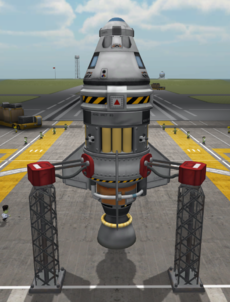Rocket


A rocket is a vertically launched craft. Usually it uses rocket engines to propel it forward and doesn't utilise the lift of wings or winglets. It only uses control surfaces to help steering in an atmosphere. The main purpose of a rocket is to reach space and an orbit, or at least a sub-orbital flight.
With various stages, rockets can dump dry mass and become more efficient, while a spaceplane usually doesn't have stages. As they don't use lift to maintain altitude, the rocket engines need to counteract gravity. To determine if the rocket can lift off, the thrust-to-weight ratio can be determined. If the ratio is above one, the thrust generated by the engines is higher than the gravitational force and thus the rocket will lift off. Because the engines drain fuel, the craft gets lighter so the ratio also increases with the flight.
Because rockets don't need lift surface, they work in every environment and don't need an atmosphere. On the other hand, rocket engines with sufficient thrust are far more inefficient than jet engines with similar thrust.
Rockets are built in the Vehicle Assembly Building and then launched on the launch pad.
Start
The usual flight profile starts on the launchpad on Kerbin. Prior to liftoff, any jet engines need to be started to run at full throttle on liftoff. When the jet engines are running at full power, the liftoff can be initiated by activating the rocket engines and releasing any TT18-A Launch Stability Enhancers.
Before the launch we should decide what kind of orbit we want to reach - prograde, polar... The tilting direction depends on the planed inclination. For example, equatorial retrograde orbit, where the crafts rotates in the other direction than the celestial body beneath it, means inclination of 180°. While the Kerbin rotates counter-clockwise, seen from the North pole, it means western direction (270°), and the prograde orbit aligned with rotation of the body means eastern direction (90°). As general, the equatorial prograde direction (exactly 90°) is the most profitable, because in this case the sidereal rotation velocity is added to the orbital speed - means fuel saving - but in case of retrograde orbit the rotation works against the rocket. The northern-southern polar orbit (inclination of 0° abd 180°) are preferable for scanning the whole area of the celestial body.
At first, rocket then starts the vertical climbing to rise and accelerate continues so until reaching the proper altitude for the pitchover maneuver. (at Kerbin it is about 2 km). At this point a gravity turn is initiated by tilting (of ~2 degrees in this case) in the desired direction. From this moment the tilt slowly and continuously increases, reaches the value of 15-20° at 10 km, and value of ~45-50° at 20 km, and increases on and on at higher altitudes. Ideally, from the pitchover maneuver there is no need of interfering - the gravity turns the rocket during the gravity turn. With the gravity turn the craft starts to pick up horizontal velocity, which is crucial for a stable orbit. The engines continuing to accelerate the vessel to raise the apoapsis and periapsis out of the atmosphere.
The altitude and the angle of the pitchover maneuver depends on the properties of the celestial body. In low-G worlds without atmosphere the pitchover manoever can be started immediately after the lift-off, and the angle is far more (several 10 degrees!), but is opposite case (Eve) the vertical climb continues for higher altitudes.
As soon as the apoapsis and periapsis are outside the atmosphere (about 69 km), the crafts orbit will not decrease, and has reached a parking orbit. From this orbit it is possible to initiate orbital maneuvers like the Hohmann transfer to change the orbital shape.